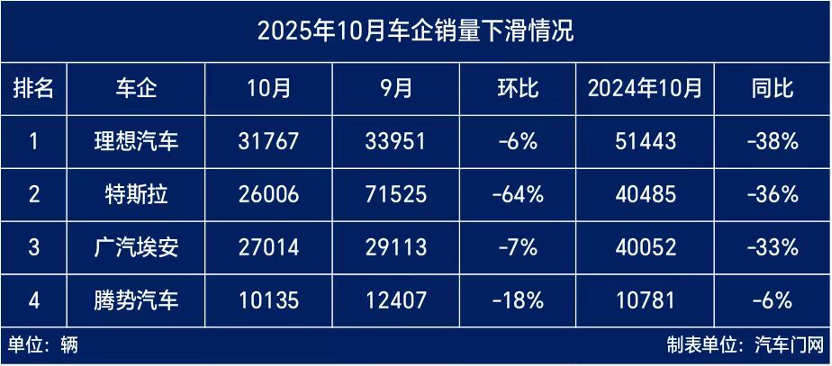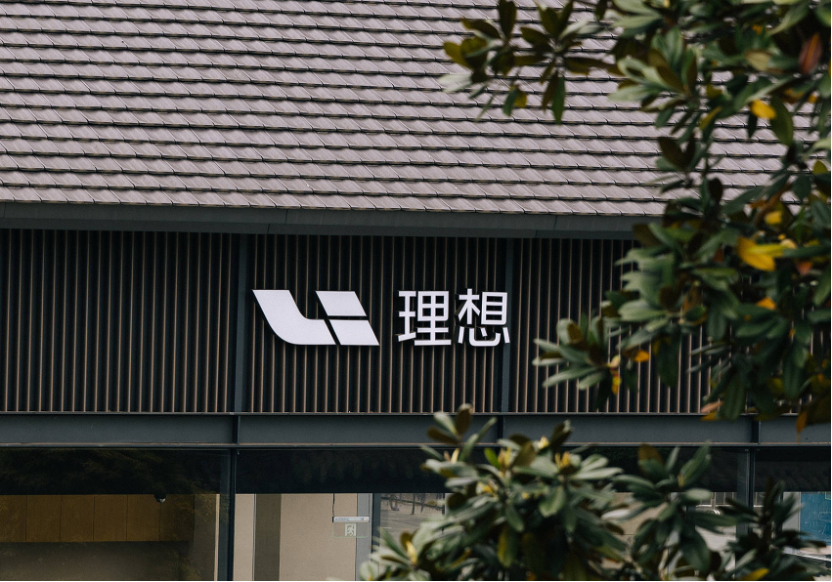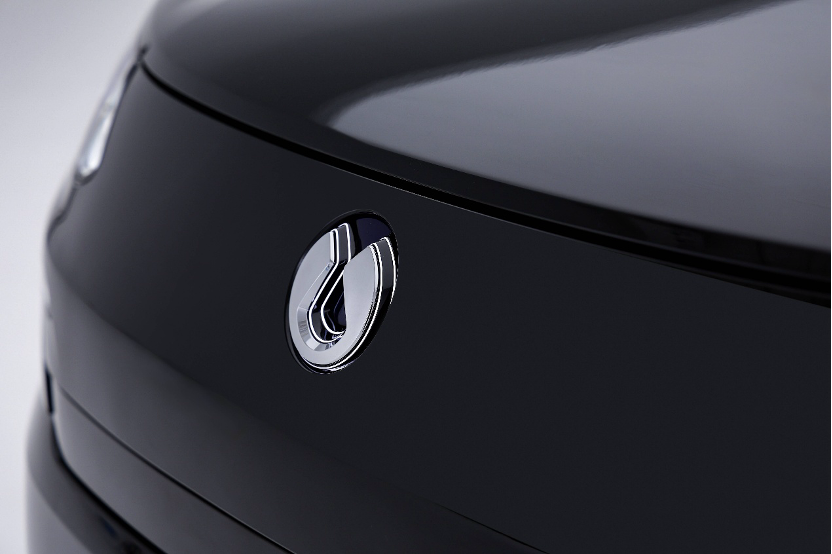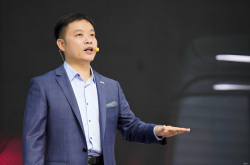Leapmotor and Other Brands Forge Ahead While Some Newcomers Stumble
![]() 11/17 2025
11/17 2025
![]() 485
485
By 2025, the automotive market has witnessed an unprecedented level of competition. Throughout this period, leading automakers have intensified their efforts to capture larger market shares. Particularly during the recently concluded 'Golden September and Silver October' sales peak, automakers have introduced a range of incentives to attract consumers and boost sales, including time-limited discounts, cash subsidies, and loan interest exemptions. Consequently, the entire new energy vehicle (NEV) sector has exhibited signs of robust growth. However, beneath this surface prosperity, some automakers continue to grapple with sluggish growth and underwhelming market performance.

Li Auto delivered another lackluster performance in the recently concluded October.
In October, Li Auto delivered 31,767 vehicles, representing a 38% year-on-year decline and a 6% month-on-month decrease. Currently, Li Auto ranks last in sales among the 'Weixiaoli' trio (NIO, XPeng, and Li Auto). More critically, since June this year, Li Auto's monthly sales have experienced year-on-year declines for five consecutive months, with the largest drop reaching 40%.
Public data indicates that currently, only the Li L6 model maintains monthly sales exceeding 10,000 units, while other models range between 2,000 and 6,000 units.
Delving deeper, on one hand, competition in the extended-range vehicle market has escalated in recent years, with models such as the Wenjie M8, Wenjie M9, Shenlan S09, Dengfeng N9, and Lynk & Co 900 entering the market and diverting market share from Li Auto's L series. This has also diluted Li Auto's unique selling proposition of offering a 'refrigerator, big-screen TV, and comfortable sofa.' On the other hand, Li Auto has yet to establish a strong foothold in the pure EV segment. Some observers note that while the pure EV models Li MEGA and Li i8 underperformed in the market, the Li i6 saw strong initial sales but lost potential customers due to production capacity constraints.
Balancing the pure EV and extended-range segments—leveraging the popularity of the i6 to expand the pure EV market while stabilizing sales in the extended-range segment—has become a core challenge for Li Auto to tackle next.

Like Li Auto, Tesla is also navigating a challenging period.
Public data reveals that Tesla sold 26,006 vehicles in China in October, marking a 35.76% year-on-year decline and a 63.64% month-on-month decrease. This represents its worst performance in nearly three years.
Breaking down the sales by model, both the Tesla Model Y and Model 3 experienced declines in October. The Model Y sold 19,488 units, 31,685 fewer than the previous month, with its ranking dropping from second to fifteenth. The Model 3 sold only 6,518 units, experiencing a sharp decline in its market position.
Some industry insiders suggest that the sales decline may be linked to Tesla's factory holiday schedule, as the company has historically seen significant month-on-month sales drops in October compared to September over the past three years. While this is a contributing factor, a more fundamental reason is that Tesla's position in the Chinese market is no longer as dominant as before.
Currently, the Chinese automotive market is increasingly competitive, with formidable rivals surrounding the Tesla Model 3 and Model Y. In the market segments where these two models compete, new entrants such as the Xiaomi SU7, Xiaomi YU7, Wenjie M7, Ledao L60, and XPeng G7 are continuously emerging. In this context, even though the two models have secured a certain market share through their first-mover advantage and brand reputation, they still face pressure from Chinese domestic models.
To stimulate sales, Tesla recently launched the Model Y L to attract potential customers and slow down the erosion of its market share. However, the market performance of the new model has so far fallen short of expectations. Some observers point out that competition in the 'large six-seater' segment is far more intense than in the mid-size pure EV SUV market, while the pricing of the new model's rear-wheel-drive long-range version lacks significant appeal.
Perhaps by introducing new technologies and affordable new models, Tesla can regain its market share.

GAC Aion is still undergoing a period of adjustment.
Data shows that GAC Aion sold 27,014 vehicles in October, marking a 7% month-on-month decline and a 33% year-on-year decrease. Notably, since May this year, GAC Aion's sales have experienced year-on-year declines for six consecutive months.
Some industry insiders point out that GAC Aion's core issue lies in its lack of true blockbuster models to drive market growth. Over the past few years, GAC Aion has relied on low-priced models to dominate the ride-hailing market, with the AION S and AION Y driving significant growth. However, as the ride-hailing market becomes saturated and the 'price war' intensifies, GAC Aion has lost its competitive edge. To boost sales, GAC Aion launched three models—AION V, AION RT, and AION UT—to enhance its competitiveness, but none of them made a significant impact. Subsequently, GAC Aion began exploring both pure EV and extended-range routes to find new growth opportunities.
Recently, GAC Aion officially commenced pre-sales for its first extended-range model, the AION i60, with a pre-sale price of 119,800 yuan for the pure EV version and 126,800 yuan for the extended-range version. Additionally, the Aion UT Super, jointly developed by GAC Aion, JD.com, and CATL, has officially entered the market with a price of 89,900 yuan. The arrival of these new models is expected to help GAC Aion boost its sales.

Dengfeng Auto's market performance has been tepid.
In October, Dengfeng Auto sold 10,135 vehicles, marking an 18% month-on-month decline and a 6% year-on-year decrease. Breaking down the sales by model, the Dengfeng D9 was the top seller with 7,062 units, followed by the Dengfeng N9 with 1,574 units, the Dengfeng Z9 with 339 units, and the Dengfeng N7 with 89 units.
From the sales breakdown, it is evident that Dengfeng Auto's sales heavily rely on the Dengfeng D9, while the performance of other models is generally weak. This market performance has also made it difficult for Dengfeng Auto to break through the '10,000 units+' monthly sales barrier.
Some observers point out that Dengfeng Auto's fundamental issues lie in its brand positioning and its relationship with BYD. Currently, the core technologies used in Dengfeng models are also applied in BYD's affordable models, and technology sharing makes it difficult for Dengfeng to establish a unique premium brand identity. More critically, Dengfeng Auto's premium positioning is not distinct enough, and consumers cannot quickly recognize its 'premium' attributes visually.
Currently, resolving the issues of brand positioning and product homogenization will be key for Dengfeng Auto to enhance its competitiveness.

Overall, while Li Auto faces diluted extended-range advantages and a lagging pure EV布局 (layout), Tesla struggles with product iteration fatigue and local competition pressure, GAC Aion lacks blockbuster models and endures market transition pains, and Dengfeng Auto suffers from a vague brand positioning and heavy product reliance. Although each has its own focus, they all point to the same proposition: in an era where consumer demand is becoming more rational and competitor offerings continue to expand, relying solely on first-mover advantage, price wars, or a single blockbuster model is no longer sustainable.
(Image source: Internet. Removal upon infringement.)







